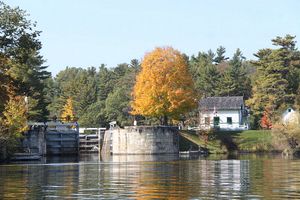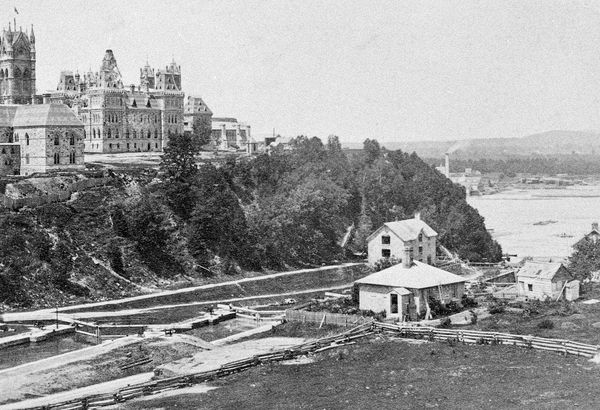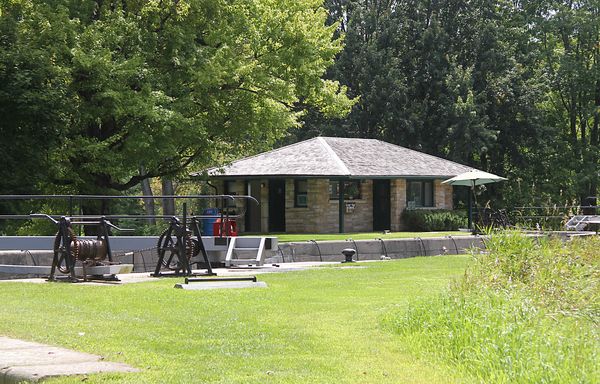Rideau Lockstation Offices
by
Ken W. Watson
Note: This article first appeared in the Fall/Winter 2021 edition of Rideau Reflections, the newsletter of the Friends of the Rideau (www.rideaufriends.com).
| |  |
| |
Davis LockThe Lockstation Office, aka Watch House, built in 1875, still sits beside the lock to this day. Photo by Ken W. Watson
|
A recent email exchange with noted Rideau Canal historian Robert W. Passfield, brought up the issue of the proper name for the modern lockstation buildings we see along the canal, should they be called a lockstation office or a watch house? That then brought up the history of those buildings and their function. In terms of function, this type of building dates back to 1875. But of course, buildings that served a similar function, but also acted as dwelling for the lockmaster, date back to 1832.
A lockmaster needs to be aware of vessel traffic approaching the lock. Up until the mid-20th century, the lockmaster lived at the lockstation. His dwelling was positioned in a spot that provided the best view. In his original plan for the Rideau Canal, Lt. Colonel John By proposed lockmaster’s houses for most lockstations. As his worries about the defence of the canal increased, he changed his plans for many of those to large and small blockhouses. At Merrickville for instance he decided to change the originally proposed lockmaster’s house to a blockhouse stating “[I] have taken upon myself the responsibility of deviating from the original plan by substituting a Block House for a Lock Master’s House for defensive reasons.” While By got a few of his blockhouses started, in 1833, the building of any new ones was stopped by the British Treasury who now had full financial authority over the canal.
The blockhouses in most spots served the dual purpose of defence and a dwelling for the lockmaster and his family. By 1834, four blockhouses had been completed, one half completed (worked stopped) and two stone lockmaster’s houses completed. In other spots, such as Davis Lock, other buildings, including former contractor’s houses, were initially used by the lockmaster.
The Upper Canada rebellion of 1837 sparked a need to bolster the defence of the canal. The British Parliament, fearful of U.S. invasion of Canada and potential rebellion of some of the citizens in its colony, approved the release of funds to complete the defensive works for the canal. So By’s plans were dusted off and work began. In 1838, non-defensible (no loopholes) stone lockmaster’s houses were built at Nicholsons, Clowes and Old Slys, but nothing further was done.
In 1838 the British government transferred several canals to the colonial government, but the Upper Canada legislature refused the Rideau and Ottawa canals since they were not seen as valuable for commerce. With the British government still very worried about the defence of Canada, they decided to transfer full control of the Rideau Canal back to Ordnance (British Army). That happened on May 20, 1840 and the Rideau returned to being operated as a full military canal. With Ordnance now in full control, a design change to the lockmaster’s houses was made with defensive loopholes added to these stone buildings. Starting in 1841, several lockstations saw these defensible lockmaster houses built. The last of these was built at Bytown (Ottawa) in 1849.
 |
Defensible Lockmaster’s House at Ottawa, c.1865
This c.1865 photo shows the defensible lockmaster’s house sitting above the Ottawa Locks. Directly in the background is the old 1827 Commissariat building, today’s Bytown Museum. The house was built in 1849 and torn down in 1875. In 1884, a lockstation office was built adjacent to the upper lock. Library and Archives Canada, C-084724.
|
In 1856 ownership and control of the canal was transferred to the provincial government and the emphasis for canal operations became the commercial use of the canal. Capital budgets for improvements basically dropped to zero. Moving ahead to 1875, it was now over 40 years since the completion of the canal and buildings being used as canalmen houses were starting to fall apart. The locks operated 24 hours a day and there was a need to have canal staff near the lock. The lockmaster’s houses were just that, dwellings for the lockmaster and his family, and, unlike under military jurisdiction, the lockmaster was not on call 24 hours a day. So, at Davis Lock, a log storage building adjacent to the lock was torn down and a watch house was built. It had an office and storage on the main floor and a dormitory for any men that needed it on the second floor. We then see this type of building start to appear at other lockstations. At Chaffeys for instance, the original one-storey storehouse was replaced by a two-storey watch house in the late 1800s. At Ottawa, the beautiful stone lockstation office was built adjacent to the upper lock in 1884. Of note, this building, still serving its purpose at Ottawa today, has more in common with the lockstation offices to come than with a watch house.
We now fast forward to the 1960s. The Department of Transport was running the Rideau Canal purely as a recreational canal and was looking to modernize the canal. There was a need at several sites to build new lockstation offices and so they had a new type of building designed, one that would conform to the typical park-like setting of a Rideau lockstation. These modern lockstation offices incorporated a watch office, a lunchroom, a workshop/storage space and public washrooms. Nine of these were built between 1967 and 1974. At Clowes for instance, the old two storey watch house, built in 1881, was torn down and replaced with a modern lockstation office.
Today, as you travel the canal, you’ll see a mix of old and “new” buildings. They all serve the same purpose as working buildings for the lockstation staff. You can still see several of the original watch houses at places such as Chaffeys, Davis and Jones Falls, although somewhat modernized over the years (i.e. electricity, indoor plumbing and some incorporating washrooms). Today, under Parks Canada, these heritage buildings should be maintained and preserved for future generations to appreciate. Even the “modern” lockstation offices speak to the continuing history of the canal. They speak to a time when the people of Canada realized the heritage value of the canal to our nation and initiated the transfer of the Rideau Canal from the Department of Transport to Parks Canada with a clear mandate to run the Rideau Canal as a heritage site.
 |
Lockstation Office at Upper Brewers
This photo is an example of the new design for a lockstation office introduced in 1967. Unlike oTentiks that visually pollute some of the Rideau lockstations today, these buildings were purpose designed to be conformable with the soft landscapes of a Rideau Canal Lockstation. Photo by Ken W. Watson
|
So, back to the initial question, is the proper name a Lockstation Office or a Watch House? Parks Canada today calls all of these buildings lockstation offices due to their function at the site. But in terms of form, watch house is perhaps more appropriate for the older structures and lockstation office for the modern buildings.
-Ken W. Watson
|